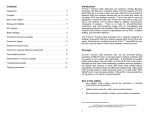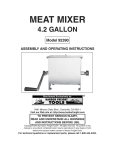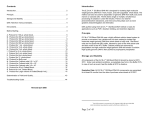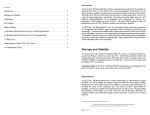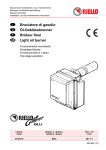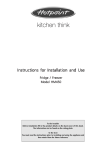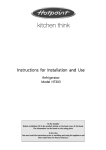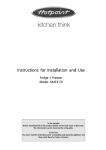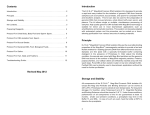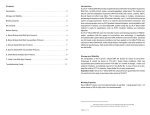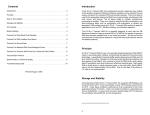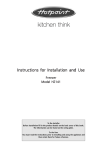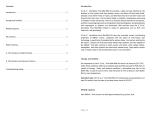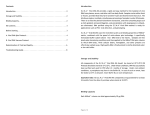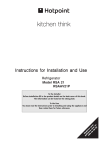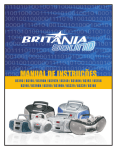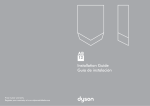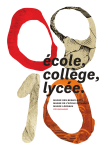Download Contents Introduction Storage and Stability Binding Capacity
Transcript
Contents Introduction Introduction. . . . . . . . . . . . . . . . . . . . . . . . . . . . . . . . . . . . . . . . . . . . . . 2 Storage and Stability. . . . . . . . . . . . . . . . . . . . . . . . . . . . . . . . . . . . . . . . 2 Binding Capacity. . . . . . . . . . . . . . . . . . . . . . . . . . . . . . . . . . . . . . . . . . . 2 Kit Contents. . . . . . . . . . . . . . . . . . . . . . . . . . . . . . . . . . . . . . . . . . . . . . 3 Before Starting. . . . . . . . . . . . . . . . . . . . . . . . . . . . . . . . . . . . . . . . . . . . 3 A. E.Z.N.A.® Protocol for Tissue. . . . . . . . . . . . . . . . . . . . . . . . . . . . . . . . . 4 B. E.Z.N.A.® Protocol for cultured cells. . . . . . . . . . . . . . . . . . . . . . . . . . . . 6 C. E.Z.N.A.® Protocol for Mouse Tails Snips.. . . . . . . . . . . . . . . . . . . . . . . . . 7 The E.Z.N.A.® Tissue DNA Kit provides a rapid and easy method for the isolation of genomic DNA for consistent PCR and Southern analysis. Up to 30 mg tissue or up to 1 cm sections of mouse tail can be readily processed in one time. The method can also be used for preparation of genomic DNA from mouse tail snips, blood, buffy coat, serum, and plasma. The kit allows single or multiple, simultaneous processing of samples. There is no need for phenol/chloroform extractions, and timeconsuming steps such as precipitation with isopropanol or ethanol, are eliminated. DNA purified using the E.Z.N.A.® Tissue DNA method is ready for applications such as PCR*, Southern blotting, and restriction digestion. The E.Z.N.A.® Tissue DNA Kit uses the reversible binding properties of HiBind® matrix, a new silica-based material, combined with the speed of mini-column spin technology. A specifically formulated buffer system allows genomic DNA up to 60 kb to bind to the matrix. Samples are first lysed under denaturing conditions and then applied to the HiBind® spin columns to which DNA binds, while cellular debris, hemoglobin, and other proteins are effectively washed away. High quality DNA is finally eluted in sterile deionized water or low salt buffer. D. E.Z.N.A.® Protocol for Paraffin-Embedded Tissue. . . . . . . . . . . . . . . . . . . 8 Storage and Stability E. E.Z.N.A.® Tissue DNA Vacuum/spin protocol. . . . . . . . . . . . . . . . . . . . . . . 9 Determination of Yield and Quality.. . . . . . . . . . . . . . . . . . . . . . . . . . . . . . 9 Troubleshooting Guide. . . . . . . . . . . . . . . . . . . . . . . . . . . . . . . . . . . . . . 10 All components of the E.Z.N.A.® Tissue DNA Kit can be stored at 22E C-25E C and are guaranteed for at least 24 months from the date of purchase.Proteinase K should be stored at 15E C-25E C. Under cool ambient conditions, a precipitate may form in the Buffer BL. In case of such an event, heat the bottle at 37EC to dissolve. Store Buffer BL at room temperature. Ordering Information. . . . . . . . . . . . . . . . . . . . . . . . . . . . . . . . . . . . . . . 12 Binding Capacity Each HiBind® DNA column can bind approximately 100 ìg DNA. Using greater than 30 mg tissue or 107 cells is not recommended. * The P C R process is covered by U .S. P atents 4,683,195 and 4,683,202 (and international equivalents) owned by H offm ann-LaR oche, Inc. 1 2 A. E.Z.N.A.® Protocol for Tissue Kit Contents Product Purification times D3396-00 D3396-01 D3396-02 5 Preps 50 Preps 200 Preps HiBind® DNA columns 5 50 200 2 ml Collection Tubes 15 150 600 Buffer TL 3 ml 20 ml 60 ml Buffer BL 3 ml 20 ml 50 ml Buffer HB 3 ml 30 ml 110 ml DNA Wash Buffer 2 ml 20 ml 3 x 20 ml Elution Buffer 3 ml 30 ml 100 ml OB Protease 150 ìl 1.4 ml 4 x 1.4 ml User Manual 1 1 1 Have the following reagents and supplies ready: ! Tabletop microcentrifuge and sterile 1.5 ml tubes. ! Warm up Elution Buffer ( 0.5 ml per sample) to 70oC. ! Have a shaking waterbath set to 55oC. ! Absolute ethanol - approximately 0.3 ml per sample. ! RNase A (Optional) - stock solution at 25 mg/ml. This method allows genomic DNA isolation from up to 30 mg tissue. Yields vary depending on source. OPTIONAL: Although no mechanical homogenization of tissue is necessary, pulverizing the samples in liquid nitrogen will improve lysis and reduce incubation time. Once the liquid nitrogen has evaporated, transfer the powdered tissue to a clean 1.5 ml tube. Add 200 ìl Buffer TL and proceed to step 2 below. Buffer BL contains a chaotropic salt. Use gloves and protective eyeware when handling this solution. 1. Mince up to 30 mg of tissue and place into a 1.5 ml microfuge tube. Add 200 ìl Buffer TL. Cut the tissue into small pieces to speed up lysis. For samples larger than 30 mg, simply scale up the volume of Buffer TL used; for a 60 mg sample use 400 ìl buffer. 2. Add 25 ìl of OB Protease and vortex to mix well. Incubate at 55oC in a shaking waterbath to effect complete lysis. If no shaking waterbath is available, vortex the sample every 20-30 minutes. Lysis time depends on amount and type of tissue, but is usually under 3 hours. One can allow lysis to proceed overnight. The volume of OB Protease (or proteinase K) used will need to be adjusted based on amount of starting material; use 50 ìl for a 60 mg tissue sample. 3. OPTIONAL: Certain tissues such as liver have high levels of RNA which will be copurified with DNA using this kit. While it will not interfere with PCR, the RNA may be removed at this point. Add 5ìl (assuming a sample size of 30 mg) RNase A (25 mg/ml) and incubate at room temperature for 2-5 minutes. Proceed with the tissue protocol. 1. 2. 3. E E E 4. Centrifuge for 5 min at 10,000 x g to pellet insoluble tissue debris. Carefully aspirate the supernatant and transfer to a sterile micro-centrifuge tube leaving behind any insoluble pellet. 5. Add 220 ìl Buffer BL and vortex to mix. Incubate at 70E C for 10 min. A wispy precipitate may form on addition of Buffer BL, but does not interfere with DNA recovery. Adjust the volume of Buffer BL required based on amount of starting material. 6. Add 220 ìl absolute ethanol (room temperature, 96-100%) and mix thoroughly by vortexing at maxi speed for 15 seconds. Adjust the volume of ethanol if greater than 30 mg tissue is used). If precipitation can be seen at this point, break the precipitation by pipetting up and down 10 times. Before Starting IMPORTANT Wash Buffer must be diluted with absolute ethanol as follows: D3396-00 Add 8 ml 96-100% ethanol D3396-01 Add 80 ml 96-100% ethanol per bottle D3396-02 Add 80 ml 96-100% ethanol per bottle Note: *All centrifugation steps must be performed at room temperature. 3 4 7. Assemble a HiBind® DNA column in a 2 ml collection tube (provided). Transfer the entire lysate from step 6 into the column including any precipitate that may have formed. Centrifuge at 8,000 x g for 1 min to bind DNA. Discard flow-through liquid. 8. (Optional) If greater than 30 mg tissue is used, repeat transfer the remaining lysate into the column and centrifuge as above. Make sure that all of the lysate has pass through the column. 9. Place the column into a second 2 ml collection tube and wash by pipetting 500 ìl of Buffer HB. Centrifuge at 8,000 x g for 1 min. Discard flow-through liquid and 2ml collection tube. 10. Place the column into a second 2 ml collection tube and wash by pipetting 700 ìl of DNA Wash Buffer diluted with ethanol. Centrifuge at 8,000 x g for 1 min. Discard flow-through liquid and re-use 2ml collection tube in next step. B. E.Z.N.A. ® Protocol for Cultured Cells Have the following reagents and supplies ready: ! Tabletop microcentrifuge and sterile 1.5 ml tubes. ! Warm up Elution Buffer ( 0.5 ml per sample) to 70oC. ! Have a shaking waterbath set to 65oC. ! Absolute ethanol - approximately 0.3 ml per sample. ! RNase A (Optional) - stock solution at 25 mg/ml. This protocol is designed for rapid isolation of up to 25 ìg genomic DNA from up to 5 x 106 cultured cells. 1. Note that DNA Wash Buffer is provided as a concentrate and must be diluted with absolute ethanol as indicated on the bottle or page 3. If refrigerated, the diluted DNA wash buffer must be brought to room temperature before use. 1b. For cells grown in suspension, pellet 5 x 106 cells by spinning at 1200 x g in a centrifuge tube. Discard the supernatant, and wash the cells once with PBS, and resuspend cells with 200ìl cold (4NC) PBS. 11. Place the column back into the 2ml collection tube from step 10, wash the column with a second 700 ìl of DNA Wash Buffer diluted with ethanol and centrifuge as above. Discard flow-through. 12. Place the column back into the same 2 ml collection tube, centrifuge the empty column at maximum speed (>12,000 x g) for 2 min to dry the column. This step is crucial for ensuring optimal elution in the following step. 13. Place the column into a sterile 1.5 ml microfuge tube and add 50-200 ìl of preheated (70oC) Elution Buffer. Allow tubes to sit for 3 min at room temperature. 14. To elute DNA from the column, centrifuge at 10,000 x g for 1 min. Repeat the elution with a second 100-200 ìl of Elution Buffer. Note: Each 100-200 ìl elution typically yields 60-70% of the DNA bound to the column. Thus two elutions generally give ~90%. However, increasing elution volume reduces the concentration of the final product. To obtain DNA at higher concentrations, elution can be carried out using 50 ìl to 100 ìl Elution Buffer (which slightly reduces overall DNA yield). Volumes lower than 50 ìl greatly reduce yields. In some instances yields may be increased by incubating the column at 70oC (rather than at room temperature) upon addition of Elution Buffer. If necessary the DNA can be concentrated. Add sodium chloride to a final concentration of 0.1 M followed by 2X volume of absolute (100%) ethanol. Mix well and incubate at -20o C for 10 min. Centrifuge at 10,000 x g for 15 min and discard supernatant. Add 700 ìl of 80% ethanol and centrifuge at 10,000 x g for 2 min. Discard supernatant, air dry the pellet (2 min) and resuspend DNA in 20 ìl sterile deionized water or 10 mM Tris-HCl, pH 8.0. 5 Prepare the cell suspension 1a. Frozen cell samples should be thawed before starting this protocol. Pellet the cells by centrifugation, wash the cells with PBS and resuspend cells with 200ìl cold (4NC) PBS. Proceed with step 2 of this protocol. 1c. For cells grown in a monolayer, harvest the cell by either using a trypsin treatment or scrape with rubber policemen. Wash cells twice, and resuspend the cells with 200ìl cold (4NC) PBS. 2. Add 25 ìl of OB Protease and vortex to mix well. Incubate at 65oC in a waterbath for 5 min to effect complete lysis. 3. OPTIONAL: Cultured Cells have high levels of RNA which will be co-purified with DNA using this kit. While it will not interfere with PCR, the RNA may be removed at this point. Add 5ìl (assuming 5 x 106 ) RNase A (25 mg/ml) and incubate at room temperature for 2-5 min. Proceed with the tissue protocol. 4. Add 220 ìl Buffer BL and vortex to mix. Incubate at 70oC for 10 min. A wispy precipitate may form on addition of Buffer BL, but does not interfere with DNA recovery. Adjust the volume of Buffer BL required based on amount of starting material. 5. Add 220 ìl absolute ethanol (room temperature, 96-100%) and mix thoroughly by vortexing at maxi speed for 15 seconds. If precipitation can be seen at this point, break the precipitation by pipetting up and down 10 times. 6. Proceed Step 7-14 of E.Z.N.A.TM Protocol for tissue on Page 5. 6 C. E.Z.N.A.® Protocol for Mouse Tails Snips D. E.Z.N.A.® Protocol for Paraffin-Embedded Tissue Before Starting have the following ready: ! Tabletop microcentrifuge and sterile 1.5 ml tubes. ! Shaking waterbath set to 55oC. ! Elution Buffer (~0,5 ml per sample) equilibrated to 70 oC. ! For each sample, premix 200 ìl Buffer BL with 200 ìl absolute ethanol and vortex. This can be prepared fresh, or pre-made and stored at room temperature. Do not store this mixture for more than 1 month. ! Have a shaking waterbath set to 55oC. ! Absolute ethanol - approximately 0.3 ml per sample. ! RNase A (Optional) - stock solution at 25 mg/ml. 1. Place not more than 30 mg tissue (~2 mm3) in a clean 2 ml microfuge tube. 2. Extract the sample with 1 ml xylene to remove the paraffin. Mix thoroughly by vortexing. 3. Centrifuge the tube at 10,000 x g for 10 min at room temperature. Discard supernatant without disturbing the tissue pellet. 4. Rinse the pellet with 1 ml absolute ethanol to remove traces of xylene. Centrifuge at 10,000 x g for 5 min at room temperature. Discard the ethanol without disturbing the tissue pellet. Bring frozen samples and OB Protease solution to room temperature and, preheat an aliquot of Elution Buffer (approximately 0.5 ml per sample) at 70oC. 5. Repeat the ethanol rinse. 1. 6. Air dry tissue pellet at 37oC for 15 min. 7. Add 200 ìl Buffer TL to the tissue and follow E.Z.N.A. Protocol for Tissue from step 2 on page 4. Snip two pieces of mouse tail 0.2 - 0.5 cm in length, place into a sterile 1.5 ml microcentrifuge tube, and add 180 ìl of Buffer TL. If necessary cauterize the wound to stop bleeding. Having appropriately earmarked the animal, return it to a clean cage. Note: Mice should not be older that 6 weeks, since lysis will be more difficult resulting in suboptimal DNA yields. If possible, obtain tail biopsy at 2-4 weeks and freeze samples at - 70oC until DNA is extracted. Add 25 ìl of OB protease and vortex to mix. Incubate in a 55oC shaking waterbath for 1-4 hours or until lysis is complete. If no shaking waterbath is available, vortex vigorously every 20-30 min. Incomplete lysis may block column flow and significantly reduce DNA yields. Incubation time for complete tail lysis is dependent on length of tail and age of animal; 0.5 cm tail pieces from 2 week-old mice typically lyse in approximately 2 hours. For older animals an overnight incubation may improve yields. Note that bone and hair will not lyse. 2. Yields will depend on size and age of sample. Certain samples may require prolonged lysis with Buffer TL. Note: Tissue fixed with paraformaldehyde will yield degraded DNA or RNA. The extent of degradation depends on type of fixative used, but the size of DNA obtained is usually less than 500 bp. Degradation is not caused by the E.Z.N.A.® Tissue DNA protocol, and for PCR detection of segments smaller than 500 bp satisfactory results can be obtained. Centrifuge for 5 min at 10,000 x g to pellet insoluble tissue debris and hair. Carefully aspirate the supernatant and transfer to a sterile microfuge tube leaving behind any insoluble pellet. OPTIONAL: Mouse tail tissue contains RNA that can co-purify with the DNA. This will not interfere with PCR reactions, but other enzymatic reactions may be affected. To remove RNA, add 15 ìl of RNase A (25 mg/ml) and incubate 2 min at room temperature. 3. Add ONE volune of BL followed by ONE volume of ethanol. Alternatively , user can add 2 volume of premixed BL/ethanol mixture to the sample. Vortex thoroughly to mix at maxi speed for 15 sec. Thoroughly mixing is essential at this point. If precipitation can be seen at this point, break the precipitation by pipetting up and down 10 times. 4. Proceed step 7-14 of E.Z.N.A. Protocol for tissue on page 5. 7 8 E. Vacuum/Spin Protocol for Tissue DNA Extraction Troubleshooting Guide Carry out disruption, homogenization, Protease digestion, and loading onto HiBind® DNA column as indicated previous protocols. Instead of continuing with centrifugation, follow steps blow. Use the table below to find solutions to any problems you may have with the E.Z.N.A.® Tissue DNA Kit. Note: Please read through previous section of this book before using this protocol. 1. Prepare the vacuum manifold according to manufacturer’ s instruction and connect the HiBind® DNA V-Spin column to the manifold. 2. Load the sample into HiBind® DNA V-spin column. 3. Switch on vacuum source to draw the sample through the column and turn off the vacuum. 4. Wash the column by adding 500 ìl Buffer HB, draw the wash buffer through the column by turning on the vacuum source. 5. Wash the column by adding 700 ìl DNA wash buffer, draw the wash buffer through the column by turning on the vacuum source. 6. Wash the column again by adding 700 ìl DNA wash buffer, draw the wash buffer through the column by turning on the vacuum source. 7. Assemble the column into a 2 ml collection tube and transfer the column to a micro centrifuge. Spin at maxi speed (no more than 20,000 x g )for 2 minute to dry the column. 8. Place the column in a clean 1.5 ml microcentrifuge tube and add 50-100ìl DNA elution buffer. Stand for 1-2 minute and centrifuge 1 minute to elute DNA. Determination of Yield and Quality Problem Possible Cause Suggestions Clogged Colum n Incom plete lysis Extend incubation tim e of lysis w ith Buffer TL and protease. Add the correct volum e of Buffer BL and incubate for specified tim e at 70 o C. It m ay be necessary to extend incubation tim e by 10 m in. Sam ple too large If using m ore than 30 m g tissue, increase volum es of O B Protease or Proteinase K, Buffer TL, Buffer BL, and ethanol. Pass aliquots of lysate through one colum n successively. Sam ple too viscous Divide sam ple into m ultiple tubes, adjust volum e to 250 ìl w ith 10 m M Tris-HCl. Clogged colum n See above Poor elution Repeat elution or increase elution volum e (see note on page 4). Incubation of colum n at 70 o C for 5 m in w ith Elution Buffer m ay increase yields. Improper washing Wash Buffer Concentrate must be diluted with absolute (100%) ethanol as specified on page 3 before use. Extended centrifugation during elution step. Resin from the column may be present in eluate. Avoid centrifugation at speeds higher than specified. The material can be removed from the eluate by centrifugation — it will not interfere with PCR or restriction digests. Poor cell lysis due to incom plete m ixing w ith Buffer BL Repeat the procedure, this tim e m aking sure to vortex the sam ple w ith Buffer BL im m ediately and com pletely.M ay 25, 2009 Low DNA yield Low A260/A280 ratio The total DNA yield can be determined by a spectrophotometer using deionized water, Tris-HCl buffer, or Elution Buffer as blank. DNA concentration is calculated as: [DNA] = (Absorbance260) x (0.05 ìg/ìl) x (Dilution factor) The quality of DNA can be assessed by measuring absorbance at both 260 nm and at 280 nm. A ratio of (A260/A280) of 1.7-1.9 corresponds to 85%-95% purity. Expected yields vary with both amount and type of tissue used. 30 mg of fresh tissue will yield 10-40 ìg DNA with two elutions (each 200 ìl). 9 10 Problem No DNA eluted W ashing leaves colored residue in colum n Possible Cause Suggestions Incom plete cell lysis or protein degradation due to insufficient incubation. Increase incubation tim e w ith Buffer TL and protease. Ensure that no visible pieces of tissue rem ained. Sam ples are rich in protein. After applying to colum n, w ash w ith 300 ìl of a 1:1 m ixture of Buffer BL and ethanol and then w ith DNA W ash Buffer. Product No. Product Name Description Blood DNA Isolation Kits Poor cell lysis due to im proper m ixing w ith Buffer BL. M ix thoroughly w ith Buffer BL prior to loading into HiBind ® colum n. Poor cell and/or protein lysis in Buffer TL. Tissue sam ple m ust be cut or m inced into sm all pieces. Increase incubation tim e at 65 o C w ith Buffer TL to ensure that tissue is com pletely lysed. Absolute ethanol not added to Buffer BL. Before applying sam ple to colum n, an aliquot of Buffer BL/ethanol m ust be added. See protocol above. No ethanol added to W ash Buffer Concentrate. Dilute W ash Buffer w ith the indicated volum e of absolute ethanol before use. Incom plete lysis due to im proper m ixing w ith Buffer BL. Buffer BL is viscous and the sam ple m ust be vortexed thoroughly. No ethanol added to W ash Buffer Concentrate. Ordering Information D3392-01/02 Blood DNA Kit Isolation of total cellular DNA from fresh and dry blood D3494-01/02 Blood DNA Midi Kit Isolation of total cellular DNA from up to 10ml blood. D2492-01/02 Blood DNA Maxi Kit Isolation of total cellular DNA from up to 20ml blood. D1192-01/02 E-Z 96™ Blood DNA Kit Isolation of total cellular DNA from fresh and dry blood with 96 well plate D3096-01/02 Micro-Spin Genomic DNA Kit Isolation of total cellular DNA from micro samples. D3396-01/02 Tissue DNA Kit Isolation of total cellular DNA from tissue samples. D1196-01/02 E-Z 96™ Tissue DNA Kit Isolation of total cellular DNA from tissue samples with 96 well plate D5197-01/12 HP Tissue DNA Midi Kit Isolation of total cellular DNA from 500mg tissue samples. D5198-01/02 HP Tissue DNA Maxi Kit Isolation of total cellular DNA from 2 g tissue samples. D3592-01/02 Forensic DNA Kit Isolation of genomic DNA from forensic samples. OB collection paper included. D3373-01/02 Mollusc DNA Kit Isolation of total cellular DNA from Mollusc samples. D0926-01/02 Insect DNA Kit Isolation of total cellular DNA from Insect samples. D4015-01/02 Stool DNA Kit Isolation of total cellular DNA from Stool samples. Tissue DNA Kits: Dilute W ash Buffer w ith the indicated volum e of absolute ethanol before use. If the above suggestions fail to resolve any problems you are having with the E.Z.N.A.® Tissue DNA Kit, please feel free to fax our technical specialists at: US customers: 800 832 8896 All other customers: (770) 931 8400 Or direct your questions via E-mail to [email protected]. 11






